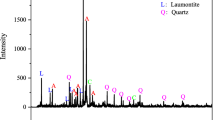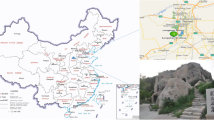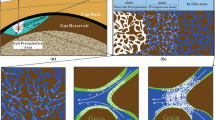Abstract
Salt and ice crystallisation in the pore spaces causes major physical damage to natural building stones. The damaging effect of these processes can be traced back to physically induced stress inside of the rock while crystallizing. The increasing scientific research done during the past century has shown that there are numerous parameters that have an influence on the weathering resulting from these processes. However, the working mechanisms of the stress development within the rock and its material dependency are still subject to discussion. This article gives an overview of salt and ice weathering. Additionally, laboratory results of various sandstones examined are presented. Salt crystallisation tests and freeze/thaw tests were done to obtain information about how crystallisation weathering depends on material characteristics such as pore space, water transportation, and mechanical features. Simultaneous measuring of the length alternating during the salt and ice crystallisation has revealed detailed information on the development of crystal in the pore spaces as well as the development of stress. These findings can help to understand the damaging mechanisms.



















Similar content being viewed by others
References
Arnold A, Zehnder K (1990) Salt weathering on monuments. In: Advanced workshop analytical methodologies for the investigation of damaged stones, 14–21 September 1990, Pavia (Italy)
Birch F (1960) The velocity of compressional waves in rocks up to 10 kilobars, Part I. J Geophys Res 65:1083–1102
Birch F (1961) The velocity of compressional waves in rocks to 10 kilobars, Part II. J Geophys Res 66:2199–2224
Brakel J van, Modry S, Svata M (1981) Mercury porosimetry: state of the art. Powder Technol 29:1–12
Charola AE, Weber J (1992) The hydration/dehydration mechanisms of sodium sulphate. In: Delgado Rodrigues J (ed) Seventh international congress on the deterioration and conservation of stone. Lisbon, pp 581–590
Charola AE (2000) Salts in the deterioration of porous materials: an overview. J Am Inst Conserv 39:327–343
Chatterji S, Christensen P, Overgaard G (1979) Mechanisms of breakdown of natural stones caused by sodium salts. In: Badan B (ed) Third international congress on the deterioration and conservation of stone. Padova, pp 131–134
Correns CW, Steinborn W (1939) Über die Erklärung der sogenannten Kristallisationskraft. Zeitschrift für Kristallographie 101:117–133
Correns CW (1949) Growth and dissolution of crystals under linear pressure. Discuss Faraday Soc 5:267–71
Darwin CR (1839) Journal of researches into the natural history and geology of the countries visited during the voyage of HMS Beagle round the world. D. Appleton, New York
Doehne E (1994) In situ dynamics of sodium sulfate hydration and dehydration in stone pores: observations at high magnification using the environmental scanning electron microscope. In: Fassina V, Ott H, Zezza F (eds) The conservation of monuments in the Mediterrane Basin. Venice, pp 143–150
Doehne E (2002) Salt weathering: a selective review. In: Siegesmund S, Weiss T, Vollbrecht A (eds) Natural stones, weathering phenomena, conservation strategies and case studies. Geol Soc Spec Publ 205:43–56
Duttlinger W, Knöfel D (1993) Salzkristallisation und Salzschadensmechanismen. Jahresbericht Steinzerfall—Steinkonservierung 1991, Ernst & Sohn Verlag, pp 197–213
Everett DM (1961) The thermodynamics of frost damage to porous solids. Trans Faraday Soc 57:2205–2211
Fitzner B (1969) Die Prüfung der Frostbeständigkeit von Naturbausteinen. Geologische Mitteilungen 10:205–296
Fitzner B, Snethlage R (1982) Einfluß der Porenradienverteilung auf das Verwitterungsverhalten ausgewählter Sandsteine. Bautenschutz und Bausanierung 3–1982:97–103
Hirschwald J (1908) Die Prüfung der natürlichen Bausteine auf ihre Verwitterungsbeständigkeit. Wilhelm Ernst & Sohn, Berlin
Kirchner D, Worch A (1993) Physikalische Vorgänge bei der Salzkristallisation. Bautenschutz und Bausanierung 16:101–103
Kiseleva OA, Kladko SN, Sobolev VD, Churaev NV (1975) Crystallisation and melting of aqueous solutions in capillaries as a model of a porous body. Colloid J USSR 37:1–37
La Plaza S, Post B (1960) Thermal expansion of ice. Acta Cryst 13:503–505
McMahon DJ, Sandberg P, Folliard K, Mehta PK (1992) Deterioration mechanisms of sodium sulfate. In: Rodriques JD, Hendriques F, Jeremisas FT (eds.) Proceedings of 7th international congress of deterioration and conservation of stone, vol 2. Portugal, Lisbon, pp 705–714
Mortensen H (1933) Die Salzsprengung und ihre Bedeutung für die regionalklimatische Gliederung der Wüsten. Petermann’s Mitteilungen aus Justus Perthes geographischer Anstalt 79:130–135
Nicholson DT, Nicholson FH (2000) Physical deterioration of sedimentary rocks subjected to experimental freezing and thawing. Earth Surf Process Landf 25:1295–1307
Powers TC (1945) A working hypothesis for further studies of frost resistance of concrete. J ACI Proc 41:245–272
Powers TC (1949) The air requirement of frost resistant concrete. Proc Highway Res Board V29:184–211
Powers TC (1955) Resistance of concrete tor frost at early ages. In: Proceedings of RILEM symposium on winter concreting, pp 1–47
Price C, Brimblecombe P (1994) Preventing salt damage in porous materials. In: Ashok R, Smith P (eds) Prepr. Contr. Ottawa Congr. Preventive conservation-practice, theory and research IIC, London, pp 90–93
Pühringer J (1983) Salt disintegration: salt migration and degradation by salt—a hypothesis. Swedish Council for Building Research D15, Stockholm
Pühringer J, Engstrom L (1985) Unconventional methods for the prevention of salt damage. In: Furlan V (ed) Proceedings of 5th international congress on deterioration and conservation of stone 1:241–250
Putnis A, Mauthe G (2001) The effect of pore size on cementation in porous rocks. Geofluids 1:37–41
Rodriguez-Navarro C, Doehne E (1999) Salt weathering: influence of evaporation rate, supersaturation and crystallization pattern. Earth Surf Process Landf 24:191–209
Rodriguez-Navarro C, Doehne E, Sebastián E (2000) How does sodium sulfate crystallize? Implications for the decay and testing of building materials. Cement Concr Res 16(3):947–954
Rossi-Manaresi R, Tucci A (1991) Pore structure and the disruptive or cementing effect of salt crystallization in various types of stone. Stud Conserv 36:53–58
Ruedrich J, Kirchner D, Seidel M, Siegesmund S (2005) Deterioration of natural building stones induced by salt and ice crystallisation in the pore space as well as hygric expansion processes. In: Siegesmund S, Auras M, Ruedrich J, Snethlage R (eds) Geowissenschaften und Denkmalpflege, Zeitschrift Deutsche Geologische Gesellschaft 156/1:59–73
Scherer GW (1999) Crystallization in pores. Cement Concr Res 29:1347–1358
Siegesmund S (1996) The significance of rock fabrics for the geological interpretation of geophysical anisotropies. Geotektonische Forschung 85:1–123
Skinner BJ (1966) Thermal expansion. In: Clark SP (ed) Handbook of physical constants. Geol Soc Am 97:75–96
Snethlage R (1984) Steinkonservierung. Bayerisches Landesamt für Denkmalpflege. Arbeitshefte 22:203
Snethlage R, Wendler E (1997) Moisture cycles and sandstone degradation. In: Baer NS, Snethlage R (eds) Saving our architectural heritage. The conservation of historic stone structures. Elsevier, Chichester, pp 7–24
Sperling CHB, Cooke RU (1980) Salt weathering in arid environments. I. Theoretical considerations. Bedford Coll Pap Geogr 9:52
Steiger M, Dannecker W (1998) Die Bedingungen für die Kristallisation verschiedener Salzhydrate am Beispiel Thenardit/Mirabilit. In: Jahresberichte Steinzerfall-Steinkonservierung, Band 6, 1994–1996. Frauenhofer IRB Verlag, Stuttgart, pp 123–133
Steiger M, Neumann HH, Grodten T, Wittenburg C, Dannecker W (1998) Salze in Natursteinmauerwerk: Probenahme, Messung und Interpretation. In: Snethlage R (ed) Natursteinkonservierung 2. Fraunhofer IRB Verlag, Stuttgart, pp 61–91
Steiger M (2005) Crystal growth in porous materials. I: The crystallisation pressure of large crystals. J Cryst Growth 282:455–469
Stockhausen N (1981) Die Dilatation hochporöser Festkörper bei Wasseraufnahme und Eisbildung. Ph.D. TU München, pp 163
Sunagawa I (1981) Characteristics of crystal growth in nature as seen from the morphology of mineral crystals. Bull Mineral 104:81–87
Taber S (1916) The growth of crystals under external pressure. Am J Sci 41:532–556
Weiss G (1992) Die Eis und Salzkristallisation im Porenraum von Sandsteinen und ihre Auswirkung auf das Gefüge unter besonderer Berücksichtigung gesteinsspezifischer Parameter. Münchner Geowissenschaftliche Abhandlungen B 9:62
Wellman HW, Wilson AT (1965) Salt weathering, neglected geological erosive agent in coastal and arid environments. Nature 205:1097–1098
Wellman HW, Wilson AT (1968) Salt weathering or fretting. In: Fairbridge RW (eds) The encyclopedia of geomorphology. Stroudsburg, Pennsylvania
Winkler EM (1968) Frost damage to stone and concrete: geological considerations. Eng Geol 2:315–323
Winkler EM, Wilhelm EJ (1970) Salt burst by hydration pressures in architectural stone in urban atmosphere. Bull Geol Soc Am 81:567–572
Winkler EM (1975) Stone: properties, durability in man’s environment, 2nd edn. Springer, Vienna, New York
Winkler EM (1994) Stone in architecture, 3rd edn. Springer, Berlin Heidelberg New York
Zehnder K, Arnold A (1989) Crystal growth in salt efflorescence. J Cryst Growth 97:513–521
Acknowledgments
We are grateful to Dirk Kirchner and Madlen Seidel for their help with the salt crystallisation tests. Thanks go to M Steiger for his comments. Our work was supported by the Deutsche Bundesstiftung Umwelt and the Deutsche Forschungsgemeinschaft (Si 438/17-1/2).
Author information
Authors and Affiliations
Corresponding author
Rights and permissions
About this article
Cite this article
Ruedrich, J., Siegesmund, S. Salt and ice crystallisation in porous sandstones. Environ Geol 52, 225–249 (2007). https://doi.org/10.1007/s00254-006-0585-6
Received:
Accepted:
Published:
Issue Date:
DOI: https://doi.org/10.1007/s00254-006-0585-6




